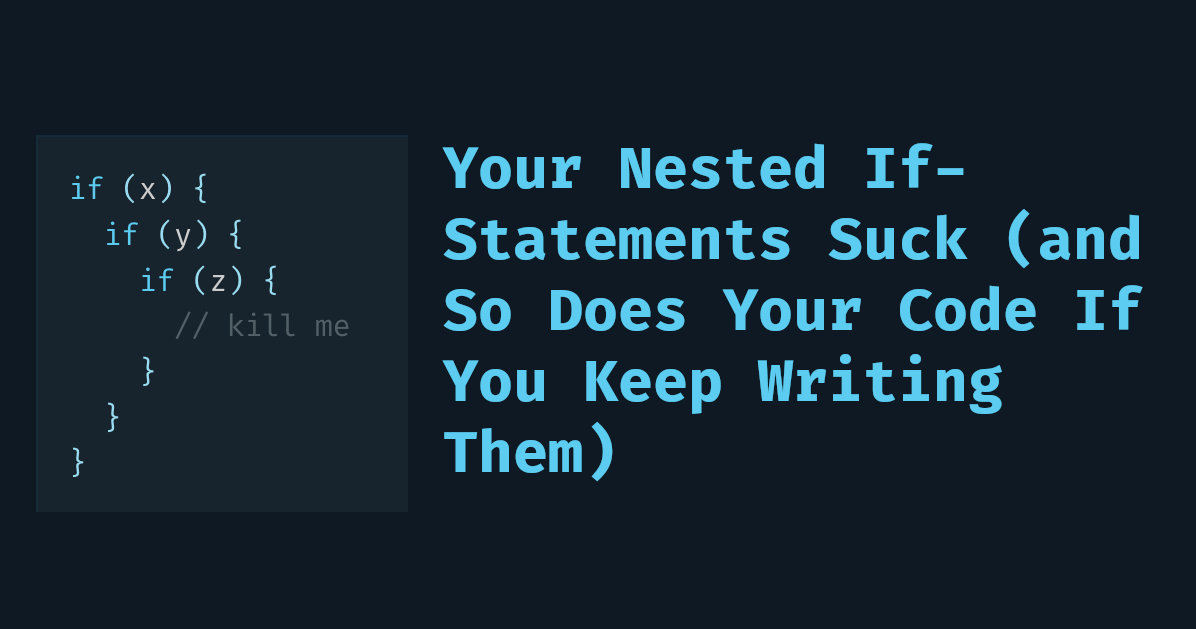Your Nested If-Statements Suck (and So Does Your Code If You Keep Writing Them)

Let’s not pretend.
You’re nesting if statements like it’s 2008 and you’re coding your first login screen.
And somehow, you’re surprised when your coworkers groan during PR reviews—or when your logic breaks under actual load. (Especially for Mission Critical Systems)
Let me save you the embarrassment.
Deep nesting isn’t “just a style.” It’s a slow, insidious form of self-sabotage that turns every function into a debugging labyrinth. And yes, it makes you look like an amateur.
Exhibit A: The Payment Validator from Hell#
function validatePayment(payment) {
if (payment !== null) {
if (payment.amount > 0) {
if (payment.currency === "USD") {
if (!payment.isRefunded) {
process(payment);
} else {
throw new Error("Payment was already refunded");
}
} else {
throw new Error("Unsupported currency");
}
} else {
throw new Error("Amount must be positive");
}
} else {
throw new Error("No payment provided");
}
}Yeah, it “works.”
So does duct tape on a fuel line.
What you’ve built is a trap:
A mental tree you have to climb, one if branch at a time.
Every new condition means more indentation, more edge cases buried three levels deep, and more chance you’ll forget what this function was even supposed to do.
Here’s the Fix: Kill It With Guard Clauses Instead of nesting logic like a Russian doll, eject early.
Introducing: Guard Clauses#
function validatePayment(payment) {
if (payment == null) {
throw new Error("No payment provided");
}
if (payment.amount <= 0) {
throw new Error("Amount must be positive");
}
if (payment.currency !== "USD") {
throw new Error("Unsupported currency");
}
if (payment.isRefunded) {
throw new Error("Payment was already refunded");
}
process(payment);
}Now we’re talking.
Straight-line logic.
Read top to bottom, like a normal human.
No mental gymnastics.
No nesting hell.
This isn’t just “clean code.” It’s survival.
Why This Matters:
- You don’t have to “remember” what level you’re on
- You don’t have to backtrack to see which condition blocked execution
- You don’t have to rewrite 14 lines because you added a single case
- And when you break it (and you will), your future self might actually forgive you
“But My Code Needs to Handle Complex Logic!”#
Cool. So does everyone else’s.
Guess what?
Nesting isn’t the solution—it’s the problem.
- Use guard clauses
- Split responsibilities
- Extract functions
- Name conditions
- Stop hiding core logic under piles of boilerplate and “what if” checks
If your function looks like a staircase, you’re doing it wrong.
if (x) {
if (y) {
if (z) {
// kill me
}
}
}This is not clever. This is a slow descent into chaos.
If you can’t describe your control flow in one sentence without stumbling, it’s too nested.
Try again.
"If there’s a user, and they have a subscription,
and they’re 18 or older, show the full version.
Otherwise—"Stop.
You already lost 80% of the room.
AI Garbage Code#
AI is trained on a wide variety of data, including beginner tutorials and outdated codebases. Since if statements are one of the first things learned in computer science, many AI models default to them—because that’s where they learned to start.
To get better output, instruct your AI to use guard clauses. Or better yet, avoid relying on AI-generated garbage code if you can.
Final Thoughts:
Early returns aren’t a “style choice.” They’re a weapon against complexity.
Use them.
Or enjoy your infinite if blocks.
Your call.